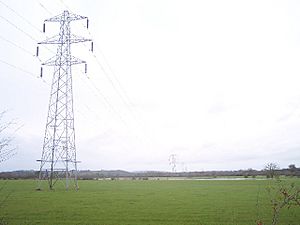Ashleworth Ham facts for kids
| Site of Special Scientific Interest | |

A view of the Ham
|
|
| Area of Search | Gloucestershire |
|---|---|
| Coordinates | 51°56′10″N 2°14′38″W / 51.936°N 2.244°W |
| Interest | Biological |
| Area | 104.73 hectare |
| Notification | 1974 |
Ashleworth Ham is a very special place for nature in Gloucestershire, England. It is a large area of grassy land on the flat ground next to the River Severn. This area is known as a "Site of Special Scientific Interest" (SSSI). This means it is protected because it has rare wildlife or geology. Ashleworth Ham was first recognized as an SSSI in 1974.
It's super important because it's one of only three places in the Severn Valley where many different kinds of water birds spend the winter. These birds travel long distances to find food and shelter here.
Part of Ashleworth Ham is looked after as a nature reserve by the Gloucestershire Wildlife Trust. This reserve is about 45 hectares (that's like 111 football fields!). There are also other important areas nearby that are part of the SSSI.
The land here is a mix of wet areas like fens, marshes, and swamps. It also has open water ditches and grassy fields. Hedges divide many of the fields, providing homes for small animals.
During winter, you can't walk directly into the reserve. This is to make sure the birds are not disturbed. But you can still watch the amazing birds from special viewing spots called hides. These hides are in a place called Meerend Thicket. This Thicket is a steep, wooded bank. It shows where the edge of the River Severn used to be much higher. Some parts of Ashleworth Ham also have very interesting plants.
Contents
Why is Ashleworth Ham Important for Wildlife?
Ashleworth Ham is a fantastic home for many different animals and plants. It's especially known for the huge numbers of birds that visit.
Amazing Winter Birds
In winter, thousands of wildfowl come to Ashleworth Ham. These include:
You might also see smaller groups of pintail and shoveler. When the area floods, you can spot diving birds like Tufted duck, pochard, goldeneye, great crested grebe, and little grebe. Regular visitors also include Bewick's swan and white-fronted geese.
Birds That Live Here All Year
Some birds choose Ashleworth Ham to build their nests and raise their young. These include:
Other breeding birds you might find are redstart, grasshopper warbler, sedge warbler, yellow wagtail, and reed bunting.
Migrating Birds and Birds of Prey
The grassy fields are also a feeding spot for many birds that are just passing through. Common snipe are the most common, but you might also see whimbrel, green sandpiper, greenshank, and ruff.
In some winters, up to 4,000 fieldfare birds gather here. This attracts birds of prey like the peregrine falcon and hobby. They come to hunt the smaller birds.
Special Plants
The plants at Ashleworth Ham are also very special. The meadows have plants like common meadow-rue and great burnet. These are typical of old, natural grasslands that haven't been changed by farming. The wooded banks, fields, and ditches are home to many different plant types. You can find golden dock, trifid bur-marigold, purple loosestrife, and several kinds of sedge plants.
How Ashleworth Ham is Protected
The main goal at Ashleworth Ham is to keep it a great home for birds and plants. This means managing the water levels very carefully. In the late 1970s, two special gates called sluices were put in. These help control how much water is in the area. A "wader scrape" was also dug. This is a shallow pool that wading birds love.
The land is grazed by animals, but only after young birds have grown enough to fly away. This protects the baby birds. The willow trees along the edges are regularly trimmed in a special way called "pollarding." This helps the trees stay healthy and provides good habitats. Any dirty mud that builds up is also carefully removed.

